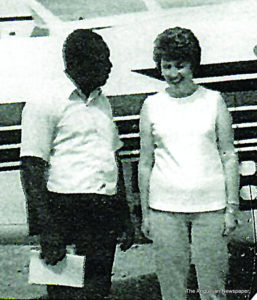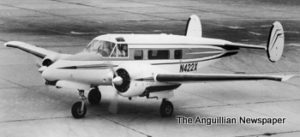
Mr. Cardigan Gumbs was an avid and dedicated employee of Capt. Clayton Lloyd’s small local airline, Valley Air Service, between the years 1967 to 1977. While he is not a pilot, Cardigan’s personality has been crafted by a love for airplanes and a passion for flying. As such, he faithfully pays tribute to Anguilla’s pilots on any occasion that is noteworthy, and he does a good job of promoting their legend and keeping their memories alive. At this time, he pays tribute to Capt. Michael Hughes on the anniversary of his passing, which occurred on March 26th 2006.
By the way, the fact is that Anguillians have always had a strong admiration and a heartfelt pride for their native aviators, and history has seen an appreciative host of them. Prior to the 1967 Anguilla Revolution, two outstanding local pilots, Clayton Lloyd (after whom the Clayton J. Lloyd International Airport is named), and his loyal colleague, Michael Hughes, one who worked assiduously with Capt. Lloyd as a piloting partner, took on the task of propelling Anguilla into its rightful position on the map.
Ever since the pre-revolution era, of the early to mid-nineteen sixties, both Capt. Lloyd and Capt. Hughes, childhood friends, played a great role in exposing Anguilla to the outside world. At that time, the island was somewhat hidden away, considered only as a backwater civilisation in the Caribbean. These two admirable airmen transported locals to and from destinations like the neighbouring islands of St. Thomas, St. Croix, St. Maarten, St. Kitts, Puerto Rico and Antigua and as far south as Dominica and Guadeloupe on occasions.
According to Cardigan, “Michael left Anguilla with many fond memories in aviation. Along with Clayton, he was instrumental in evacuating the battalion of Kittitian policemen out of Anguilla during the decisive Revolution. Both he and Clayton had proudly worked as aviation professionals in Anguilla’s airline company, Anguilla Airways, before Clayton, as Anguilla’s first pilot, ventured out to establish his own Valley Air Service. Valley Air Service (VAS) was respected as one of the area’s most popular airlines.”
“Michael had flown primarily three models of airplanes,” Cardigan said. “These included the popular Piper Aztec, the Piper Navajo; and the Twin Beech 18 (the tricycle gear type). These planes were flown at a time when Anguilla’s Wallblake Airport — as it was then named — featured not much more than a dirt runway topped with dusty marl. There were no runway lights for late flights, and any flying taking place after dark was assisted, while landing, by the headlights and tail lights of two cars.”

Cardigan described how the lighting system worked: “One car would be parked close to the foot of the runway with its headlights shining eastward over a certain span of the runway,” he explained. “The glare of those headlights lights would guide the pilot in. Another car would be stationed a short way beyond the terminal building facing eastward in a similar position to the first car, and the pilot would use its red tail lights as an indication to take a left turn onto the slender terminal apron. This crude ILS (Instrument Landing System) was what pilots like Michael and Clayton — and all who would come after them — had to work with until a more efficient lighting system was installed, in the late sixties, by British engineers, after UK paratroopers had invaded the island.”
Continuing his tribute, Cardigan reflected: “The airport runway was a real hazard,” he said. “There were not just dust, and gravel, and a lack of lighting, but the airstrip was plagued by stray animals as well — as sheep and goats roamed the nearby field for pasture. A notable memory of Michael was that one day, as he touched down on a trip from St. Thomas, a flock of sheep sped across the runway. All but one fled to safety. The ewe was struck and killed by the step of the Piper Aztec — which was suspended from the centre of the right side of the fuselage.”
Cardigan went on: “Michael left Anguilla for Canada in the mid-seventies to take up studies with Air Canada. There he pursued a course in avionics before returning to Anguilla for a short stint of work with Valley Air Service. This was a couple years prior to Clayton’s fatal crash, which occurred while approaching St. Maarten’s Juliana Airport. By that time, Michael had returned to Canada to resume his work in avionics. After a short period of illness, he ultimately died there on March 26, 2006.”
“He was a friendly, jovial man,” Cardigan said, “and he was a positive, confident pilot. I treasure the years that I worked along with him. Memories of him, Clayton and the entire Valley Air Service team are worthy to be passed on to future generations. My memories of Capt. Michael Leroy Hughes will always live on.”








